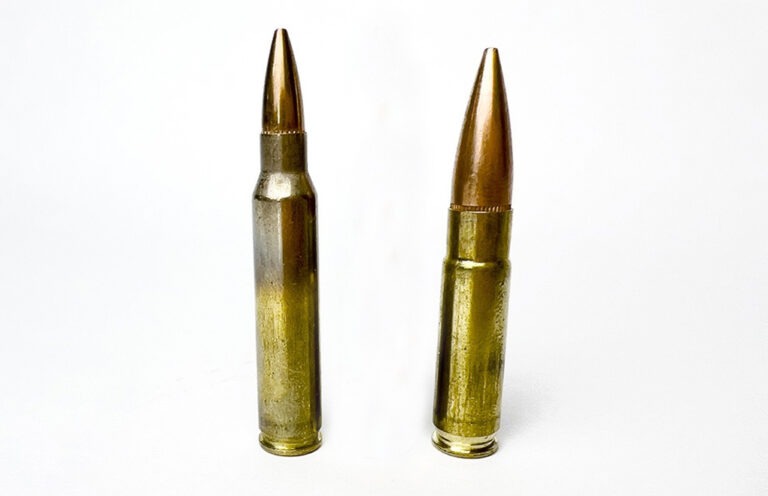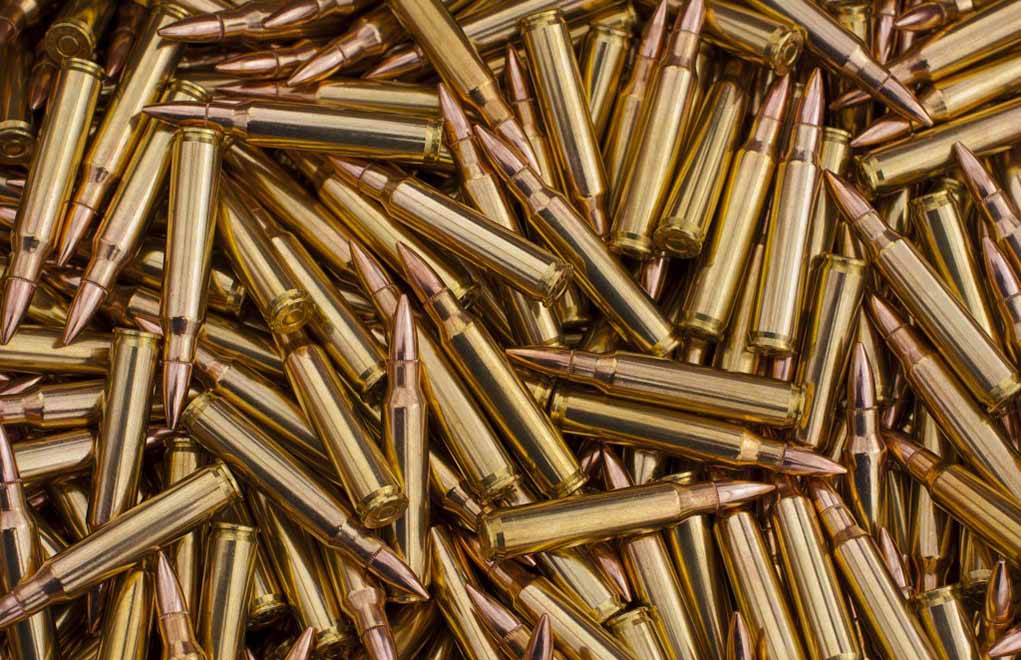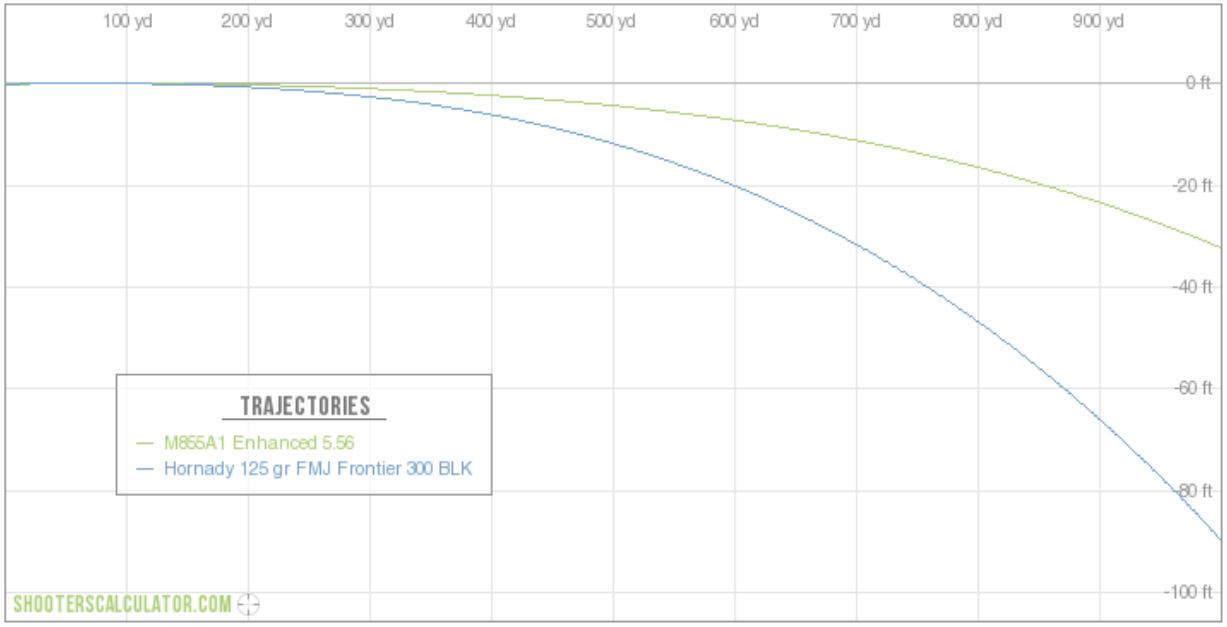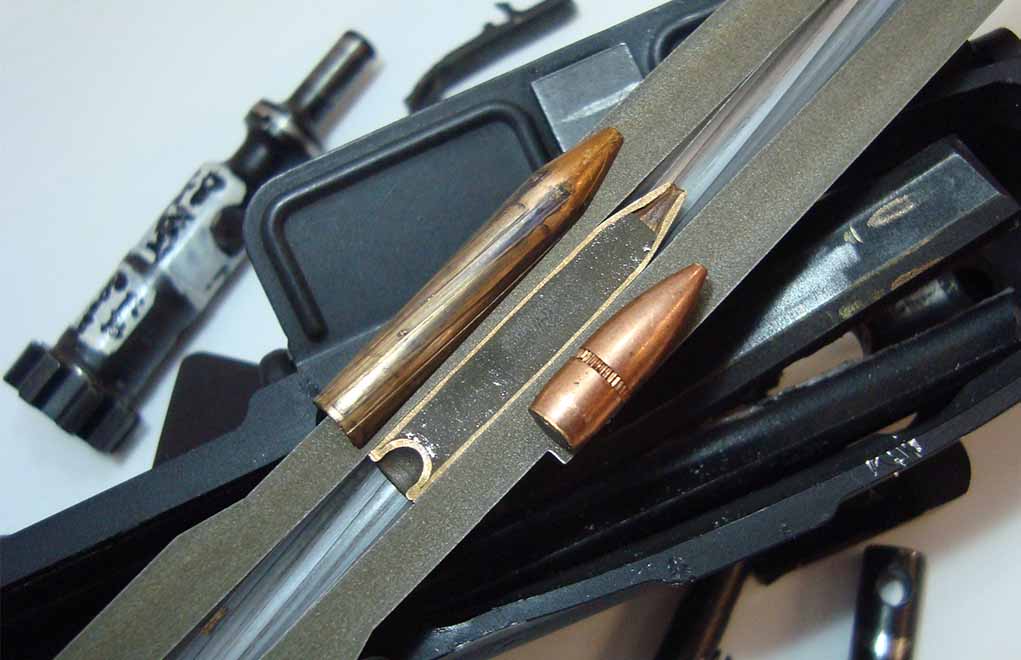
The 300 Blackout Vs 5.56 conversation is like debating apples and oranges.
The Bright Line Between 300 Blackout and 5.56 NATO:
- Similarities between the cartridges end with them sharing the same case and being tailored for military use.
- Thanks to its higher velocities, the 5.56 is much more adept at longer ranges.
- The standard .22-caliber also performs better out a longer barrel.
- 300 Blackout is less finicky about barrel length and is excellent out of SBRs.
- The .30-caliber is hands down the more suppressible of the two, with ample subsonic loads available.
By now, most everybody knows the 5.56×45mm NATO cartridge. Its fortunes are tied to America’s most popular rifle—the AR-15—the small-bore thunderbolt has become among the most shot centerfire cartridges in the world. As it goes, success breeds competition, and since its adoption by the U.S. military more than one contender has attempted to knock it off its throne. Most have proven mere pestering flies to the king, but not the 300 Blackout.
Admittedly, Blackout—formally known as the 300 AAC Blackout—is still a comparatively niche chambering compared to the 5.56 NATO. AR-smiths across the board offer the latter, not as often the former. Yet, the .30-caliber cartridge’s popularity and stability are impressive, especially for an AR option dubbed by many naysayers as a “flash in the pan” from the start. By far, the .300 Blackout is the second-most popular AR chambering of all time and arguably earned consumer shooters’ respect quicker than even the old standby AR cartridge.
For those who don’t already have both in their gun locker, the 300 Blackout vs 5.56 NATO question is pertinent. There are few dividing lines quite as bright as the one drawn between the two most popular AR cartridges on the market. I'm a big fan of both, but you need to understand how they vary if you want to employ them in the correct context.
History Of Service
Most times, the history of a cartridge’s development sheds light on its particular aptitudes, given they were tinkered to specific performance specifications. This is especially true when it comes to the 5.56 NATO and 300 Blackout. Both were tailored for military service, and used the Soviets’ 7.62×39mm cartridge as their measuring stick. But each was dialed in for much different operational settings, and thus excel in different areas.
5.56 NATO
Advantages:
- Can reach out further than 300 BLK
- Better against body armor
- Lower recoil allows for faster follow-up shots
- Lighter ammo, easier to carry
- Standard military cartridge—better availability of ammo and parts
The 5.56 NATO origin story runs through the turbulent 1960s and the Vietnam War. The knives had been out for the service rifle America entered the war with—the M14, chambered in .308 Winchester/7.62×51 NATO. Lackluster performance against North Vietnamese’s AK-47s sealed the rifle’s and cartridge’s fate, as politicos and the Pentagon went searching for a lighter, intermediate option that mirrored its adversary’s weapon.

Eventually, the AR-15 (M16 when adopted by the military) and 5.56 NATO became the choice. What made the 5.56 NATO so appealing for warfare were two main factors: weight and cost.
A single round of 5.56 NATO weighs substantially less than a single round of 7.62. Therefore, a soldier could carry more on his person, and the logistic corps could fit more rounds per truckload. Given numerous post-World War II studies showed proximity to the enemy and volume of fire were keys to winning a firefight, the .22-caliber was perfect for the job. Since it’s a smaller round, requiring less material to construct its bullets and a smaller powder charge to launch it, it was also less expensive—particularly compared to its .30-caliber predecessor.
While it might irk some old-timers—and not delving into the horrendous rifle failures of Vietnam—the 5.56 made for better marksmen as well. The 55-grain bullet moving at 3,250 fps (original specs from the military’s first load) from the AR-15’s muzzle showed improved hits over the M14 and 7.62. The round remained supersonic out to 500 yards and passed the Army’s penetration tests in spades, making it a deadly effective intermediate option—one that's been serving the country well since 1964.
Of course, our military is now supposedly planning on replacing 5.56 NATO with .227 Fury/6.8x51mm, a full-power cartridge that is as roughly heavy as 7.62 NATO and even more expensive to produce. I'll save my thoughts on why I think that's a very dumb idea for a separate article.
Pros
- High velocity, flat trajectory
- Very low recoil
- Excellent terminal ballistics at optimal velocity
- Lightweight
- Most common rifle cartridge in U.S., more affordable ammo
Cons
- Ballistics are very dependent on barrel length
- Subsonic loads unviable for most tasks, so shooting suppressed will still result in supersonic crack
300 BLK Vs 5.56 NATO Case Comparison
| Cartridge | Case Type | Bullet Diameter | Neck Diameter | Shoulder Diameter | Base Diameter | Rim Diameter | Rim Thickness | Case Length | Cartridge Length | Primer |
| 5.56x45mm NATO | Rimless, bottleneck | 0.224 | 0.249 | 0.349 | 0.373 | 0.375 | .041 | 1.76 | 2.26 | Boxer |
| .300 AAC Blackout | Rimless, bottleneck | .308 | 0.334 | 0.361 | 0.375 | 0.375 | 0.045 | 1.368 | 1.78 | Small rifle |
300 Blackout
Advantages:
- Better for shooting suppressed
- Bigger bullet, can be more effective at closer ranges, good for hunting
- Retains good ballistics out of very short barrels
- Commonly offered in both supersonic and subsonic varieties
How do you get 7.62×39 ballistic performance out of an AR? Seems the answer is the 300 Blackout. Just don’t think the relatively new cartridge was the first crack at seating a .30-caliber bullet in a .223 Remington case. J.D. Jones did a spell before Advanced Armament Corporation got the Blackout standardized by the Sporting Arms And Ammunition Manufacturers Institute (SAAMI) in a little wildcat known as the .300 Whisper. (Patrick Sweeney has an exceptional write-up on the 300 Blackout vs .300 Whisper and their minute differences.)

Whisper or Blackout, the cartridge is extremely innovative on several levels. Not only does it do a bang-up job of replicating the iconic Soviet cartridge’s ballistics, but it does so with minimum modification to the AR platform. Barrel switch and that’s it; you've gone from 5.56 to 300 Blackout. Bolt, magazine, gas system can all stay the same.
That’s handy, but what the cartridge is best known for is what its wildcat predecessor was created for—suppression. Go heavy with bullet weight, say 220 grains, and subsonic in velocity, and the 300 Blackout is as quiet as a church mouse fart (my favorite quality of 300 BLK). Suppression isn't it's only forte, however, as the Blackout doesn’t lose a beat when shot out of short-barreled rifles. If you want a super short AR as a truck or backpack gun, I think .300 BLK is the only sane choice. Don't believe me? Go look at the ballistics for 5.56 NATO when it's coming out of an 8-inch barrel.
Bone Up On AR-15 Cartridges:
- AR-15 Calibers And Cartridges: What Should You Chamber Your Carbine?
- AR-15 Basics: .223 vs. 5.56×45 NATO
- Why Buy A 6.5 Grendel?
- .350 Legend Vs .450 Bushmaster: Does One Win Out For Hunting?
The combination of all three traits is what piqued the military’s interest, but not for any mainstream duty. Instead, special operations—hamstrung by suppressed pistol-caliber sub-machine guns and carbines—found it an especially potent upgrade. The punch of a rifle round, quiet as a graveyard when suppressed and adaptable to most configurations made it a flexible tool, malleable to mission criteria.
Pros
- Subsonic loads great for shooting suppressed
- Still effective out of very short barrels
- Heavier bullet can have ballistic advantage at closer ranges
- Available in supersonic and subsonic loads
Cons
- Not as effective at longer ranges, steeper trajectory
- Heavier ammo
- If loaded into a 5.56 rifle and fired it could blow it up
- More expensive than 5.56
300 Blackout vs 5.56 NATO Ballistics
Given their much different ends, it’s no surprise the two cartridges contrast each other in performance. As a general rule, the 5.56 NATO shoots flatter and, true to its original parameters, doles plenty of damage out to 500 yards. Farther out, as the round stays supersonic for a spell, it takes a steady hand to keep the light, wind-sensitive bullets on targets.

Theoretically, supersonic 300 Blackout has the ability to make it a threat at 500 yards, though I doubt I'd want to take that distance on a target I must land a shot on. Given the mild velocities—somewhat akin to the .30-30 Winchester—and pedestrian ballistic coefficients for the caliber, its bullets drop relatively quickly. This is especially true compared to the 5.56.
An example is in order. Take the U.S. Military’s 5.56 M855A1 Enhanced Performance Round (.371 BC, 2,970 fps MV) and a somewhat comparable load for the 300 Blackout, Hornady’s 125 gr FMJ Frontier (.250 BC, 2,160 fps MV). At a mere 200 yards with a 100 zero, the 300 Blackout drops nearly 5.5 inches more than the 5.56, at 300 yards it drops a whopping 19-inches more. From there it really degrades. By and large, the relatively rapid loss of velocity confines the 300 Blackout to near medium and close ranges.
Terminally, especially in the context of hunting anything larger than a coyote, the Blackout has the upper edge. True enough, the 5.56 and .223 Remington have taken deer and are popular (and legal) options in many corners of the county. However, numerous hunters consider a .22-caliber too light for big game, and quite a few state divisions of wildlife agree.
For instance, according to my home state of Colorado’s DOW, a big-game hunter must be armed with “Rifles using center-fire cartridges of .24 caliber or larger, having expanding bullets of at least seventy (70) grains in weight, except for elk and moose where the minimum bullet weight is eighty-five (85) grains, and with a rated impact energy one hundred (100) yards from the muzzle of at least one thousand (1000) foot-pounds as determined by the manufacturer's rating … .”
There are plenty of 300 Blackout loads that meet the criterion laid out by the Centennial State to hunt every one of its big game species. Though, dust up on your stalking skills if the smallish .30-caliber is your choice.
| Cartridge/Load | G1 BC | Muzzle Velocity |
| 5.56x45mm NATO 62gr M855A1 | 0.371 | 2,970 fps |
| 300 BLK Hornady 125gr FMJ Frontier | 0.250 | 2,160 fps |
Rifle Configuration
For most, this is where the rubber hits the road in the 300 Blackout vs 5.56 NATO discussion. Every shape and size of AR is chambered for both cartridges, but each excels in different configurations. I like to think small with the 300 Blackout and go long with the 5.56 NATO.
Since it was designed with short-barreled rifles in mind and is suitable for close-in work, the 300 Blackout makes a much more logical AR pistol option. For hunting, carbine length has served me well and I've found makes for a nimble companion in the woods. When suppressed, the ability to eschew one's earpro while traipsing around is the cherry on top.

The 5.56 is more than functions in a pistol configuration, but at the sacrifice of velocity. You’ll have more than enough for CQC if that’s your aim. But if you have a yen to let the reins out on your rifle or want to pick off called coyotes, you’ll likely be happier with a carbine-length barrel or longer. Hell, if you don’t foresee pieing corners, you might even consider a classic 20-inch barreled rifle–my favorite barrel length for the caliber–many of which are out and out tack drivers. Being the original configuration, I think it's a shame how 20-inch ARs have fallen out of popularity these days, with many younger shooters having never even shot one. If that's you, do yourself a favor and try one sometime, they're buttery smooth shooters compared to any carbine.
One last note, suppressed shooting is a no brainer … 300 Blackout. It’s where the cartridge’s roots are laid and there’s ample subsonic ammunition available.
Parting Shot
It should go without saying, when talking 300 Blackout vs 5.56 in the AR platform, there’s little reason to settle for one or the other. You always have the cost-effective option of having different uppers for each cartridge, in case you can’t make up your mind. But if you run a domestic-beer budget, define mission parameters for your AR, and the clear choice of cartridge will shine through.

Next Step: Get your FREE Printable Target Pack
Enhance your shooting precision with our 62 MOA Targets, perfect for rifles and handguns. Crafted in collaboration with Storm Tactical for accuracy and versatility.
Subscribe to the Gun Digest email newsletter and get your downloadable target pack sent straight to your inbox. Stay updated with the latest firearms info in the industry.

![Best Concealed Carry Guns In 2025 [Field Tested] Wilson Combat EDC X9S 1](https://gundigest.com/wp-content/uploads/Wilson-Combat-EDC-X9S-1-324x160.jpg)


![Best 9mm Carbine: Affordable PCCs [Tested] Ruger Carbine Shooting](https://gundigest.com/wp-content/uploads/Ruger-Carbine-Shooting-100x70.jpg)
![Best AR-15: Top Options Available Today [Field Tested] Harrington and Richardson PSA XM177E2 feature](https://gundigest.com/wp-content/uploads/Harrington-and-Richardson-PSA-XM177E2-feature-100x70.jpg)

Screaming for an editor. My brain hurts from reading this.
I have heard that the 300 BO round will allow a rifle chambered in 5.56 to go into battery and could fire. I don’t have a 300 BO but maybe someone has tried this on the bench or something. My concern is that I or someone in my party could mix up the mags and have a catastrophic failure. If one of your gun smith buddies could give me the real answer I would appreciate it. This concern has kept me from a 300 BO because the risk is too horrible to take.
I have both the 300 blackout and the NATO uppers and your assessment is spot on. You can pick up the full upper for under $300 so why not have both.